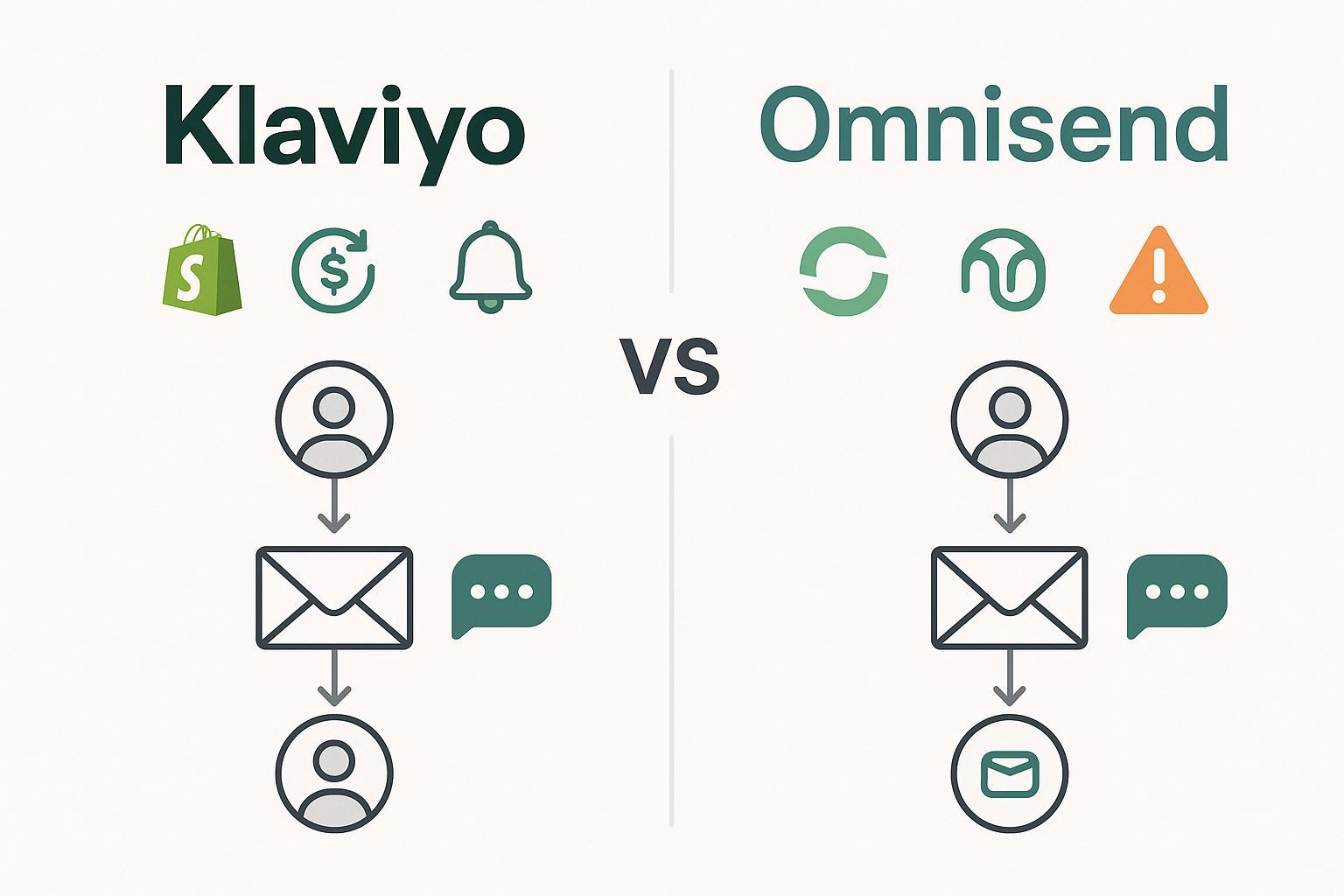Klaviyo vs Omnisend: Which Email Tool Is Better for Subscription Businesses (2025)?

Subscription ecommerce has different needs than one‑time retail: renewal reminders, failed‑charge dunning, churn‑risk segments, and crystal‑clear reporting on recurring revenue. In 2025, Klaviyo and Omnisend are two of the most popular choices for Shopify‑based operators. This review compares them through a subscription lens—integrations with Recharge/Skio/Bold/Loop, automation depth, segmentation & AI, pricing (email + SMS), deliverability tooling, reporting/attribution, onboarding/migration, and support.
How we compared (and what we didn’t assume)
- We focused on subscription‑specific workflows: upcoming renewals, failed payments, churn prevention, and win‑back.
- We validated claims against official documentation where available and avoided speculative deliverability “winner” calls because no credible 2024–2025 head‑to‑head inbox placement data was found.
- Pricing references are linked to each product’s official page and noted “as of Oct 2025,” since tiers and credits change frequently.
Subscription app integrations: the make‑or‑break factor
For subscription brands, whether your ESP can receive lifecycle events (renewed, failed, cancelled, reactivated) from your subscription app determines how powerful your flows can be.
- Klaviyo + Recharge: Recharge streams subscription events into Klaviyo as metrics; merchants can trigger flows for renewal reminders, dunning, and win‑back using these events. Recharge also offers pre‑built Klaviyo flow templates for common scenarios, documented in the Recharge pre‑built flows for Klaviyo (2025) guide and the broader Recharge metrics → Klaviyo flows (2025) article.
- Klaviyo + Skio: Skio supports event streaming via native/webhook methods (e.g., subscriptionCreated, paymentFailed), enabling Klaviyo dunning and subscriber lifecycle segmentation. See Skio’s Payment Recovery (2025) documentation for how subscription events feed ESP flows.
- Klaviyo + Bold/Loop: We did not find vendor‑hosted Klaviyo setup docs for Bold Subscriptions or Loop. Bold documents its own email notices, but Klaviyo usage is typically via custom webhooks/API or Shopify data. Loop references marketing integrations generally but lacks a detailed Klaviyo guide. Treat both as feasible but custom.
- Omnisend + Loop/Recharge: Loop’s materials reference Omnisend among marketing integrations, and Omnisend’s App Market lists partners. However, event depth depends on each app’s integration. Confirm the exact subscription events supported by your app before committing.
Takeaway: If you run Recharge or Skio and need deep, event‑driven lifecycle flows, Klaviyo’s documented pathways are a practical advantage. Omnisend can work—especially with Loop—but verify the events you’ll receive.
Lifecycle automation depth: renewals, dunning, churn
- Klaviyo: A mature flow builder with conditional splits, multi‑metric triggers, and transactional email options. Paired with Recharge or Skio, you can orchestrate multi‑touch dunning (email + SMS), renewals, and save‑offers based on cancellation intent.
- Omnisend: Strong multi‑channel builder with email, SMS, and web push in one place; conditional logic is solid. Subscription lifecycle flows are only as rich as the events pushed from your subscription app via API/webhooks.
A realistic pattern for failed payment recovery:
- Payment failed event triggers SMS with a secure payment‑update link.
- Follow‑up email 2–4 hours later with alternate payment methods.
- Reminder sequence over 3–5 days with escalating clarity and potential incentives.
To boost identification and event capture for these flows beyond ESP pixels, many brands add first‑party tracking. See the short guide to Getting started with Attribuly Pixel for server‑side Shopify events that can improve abandoned cart and dunning detection.
Segmentation & AI: predicting risk vs accelerating setup
- Klaviyo (2024–2025): Predictive analytics (CLV, churn risk, next order date) plus natural‑language segment creation. The Help Center’s 2025 article on Defining segments with AI outlines how lifecycle teams can create segments like “Subscribers at high churn risk with >3 orders and next charge in 7 days.”
- Omnisend (2025): AI Segment Builder and content AI enhancements are logged in the official Omnisend changelog (May–June 2025 updates), bringing plain‑language segment creation and quick content drafting to more users.
Practical subscription examples:
- Upcoming renewal cohort: Subscribers with next charge in ≤7 days, no support tickets, high LTV → send renewal confirmation + accessory upsell.
- Dunning cohort: Payment failed in last 24 hours; prioritize SMS first, then email; suppress customers who already updated payment.
- Churn‑risk cohort: High predicted churn + 2 failed renewals → route to CX + special save‑offer.
Klaviyo’s predictive layer is a differentiator for teams who model risk and tenure. Omnisend’s AI tools focus more on setup speed and content assistance—valuable for lean teams.
Pricing & SMS costs (as of Oct 2025)
- Klaviyo: Bills on active profiles with Email‑only and Email+SMS tiers. The official page lists current caps and credits; entry tiers for small lists are typically modest, but costs rise with profile growth—maintaining suppression hygiene is essential. Check the Klaviyo pricing page (2025) for up‑to‑date plan details and SMS credit rates by country.
- Omnisend: Free, Standard, and Pro tiers priced by contact count. Pro includes monthly SMS credits roughly equal to plan price; beyond credits, SMS is PAYG by country. See the Omnisend pricing page (2025) for exact tiers and credits.
Guidance for subscription brands:
- Model event‑driven SMS volume: dunning flows can generate concentrated SMS sends on billing days; map expected fails per 1,000 subscribers to forecast cost.
- Watch incremental list growth: add subscribers prudently and suppress inactives to avoid paying for non‑engaged profiles/contacts.
- Budget for transactional‑adjacent messaging: renewal confirmations, payment updates, and policy changes should be prioritized for deliverability and cost control.
Deliverability tooling (no head‑to‑head claims)
We did not find credible 2024–2025 inbox placement benchmarks comparing Klaviyo vs Omnisend. Both provide deliverability guides and tooling; outcomes hinge more on sender practices than platform brand.
- Klaviyo: Authentication setup (SPF/DKIM/DMARC), reputation monitoring, suppression and segmentation tools, and best‑practice documentation.
- Omnisend: Delivers guidance and monitoring across channels; public resources cover list hygiene, authentication, and engagement drivers—see Omnisend’s 2025 deliverability content and updates in their changelog.
Priorities for subscription flows:
- Authenticate and align sending domains before scaling dunning.
- Use high‑intent segments; avoid over‑sending on renewal weeks.
- Monitor complaint/bounce spikes and pause segments showing risk.
Reporting & attribution: what your ESP sees—and what it misses
Both tools attribute ecommerce revenue to campaigns and flows, which is sufficient for many operators. Subscription brands, however, often need multi‑touch clarity (email + SMS + ads), recurring order attribution, and visibility into anonymous/“dark” traffic.
To improve accuracy for lifecycle flows (renewals, dunning, win‑backs) and unify cross‑channel contributions, many brands augment ESP reporting with first‑party tracking and attribution. If you’re on Klaviyo and want to measure flow‑level revenue more precisely, review the Klaviyo integration on Attribuly to understand how server‑side events and identity resolution can complement ESP analytics.
Onboarding, migration, and support
- Klaviyo: Extensive partner ecosystem and templates; most migrations are handled by agencies/partners or in‑house teams. Documentation depth is strong.
- Omnisend: Frequently promotes migration assistance (including from Klaviyo), helping replicate segments, automations, and forms with fast turnaround; 24/7 support is commonly cited. Verify current offers on their site.
Product capsules
Klaviyo
- Overview: Data‑rich ESP with predictive analytics and a mature flow builder.
- Standout for subscriptions: Documented event streaming via Recharge and Skio enables robust renewal, dunning, and churn workflows.
- Pros
- Deep segmentation with predictive CLV/churn/next order.
- Flexible multi‑metric flow triggers; transactional email options.
- Broad partner ecosystem for setup/migration.
- Cons
- Active‑profile billing can scale quickly without suppression discipline.
- Bold/Loop integrations often require custom work; not vendor‑documented.
- SMS pricing varies by region; monitor credits and consumption.
- Pricing (as of Oct 2025): See the official Klaviyo pricing page for current tiers and credits.
- Who it’s for: Brands with Recharge/Skio that need predictive segmentation and sophisticated, event‑driven lifecycle flows.
- Evidence links: Recharge pre‑built flows (2025); Skio Payment Recovery (2025); Klaviyo AI segment help (2025).
Omnisend
- Overview: Accessible omnichannel ESP with integrated email, SMS, and web push and fast setup.
- Standout for subscriptions: Viable with Loop and potentially Recharge via API/webhooks; strength is speed and affordability for simpler lifecycle triggers.
- Pros
- Lower entry pricing with generous features on Free/Standard.
- AI Segment Builder and content AI improve velocity for lean teams.
- Integrated SMS/web push; widely cited responsive support.
- Cons
- Depth of subscription events varies by app; confirm triggers before architecting flows.
- Fewer vendor‑hosted docs for Recharge/Loop event mappings.
- Advanced deliverability monitoring may be lighter than specialized tools.
- Pricing (as of Oct 2025): See the official Omnisend pricing page for tiers, send limits, and SMS credits.
- Who it’s for: Budget‑conscious teams, mixed revenue brands where subscriptions are modest, or operators prioritizing speed and consolidated channels.
- Evidence links: Omnisend changelog (2025 updates) for AI/feature notes.
Which should you choose? Scenario‑based guidance
-
Choose Klaviyo if:
- You rely on Recharge or Skio and need granular, event‑driven lifecycle automations.
- Predictive segmentation (CLV, churn) will guide retention decisions.
- You can enforce list hygiene to control active‑profile costs.
-
Choose Omnisend if:
- You prioritize affordability and fast execution with solid omnichannel flows.
- You use Loop or have basic subscription triggers via Shopify/API and want predictable Pro‑tier SMS credits.
- Your team benefits more from content/segment AI assistance than predictive modeling.
-
Mixed stacks:
- If subscriptions represent a small share of revenue, Omnisend’s cost/value balance is compelling.
- If subscriptions drive the business and you need deep dunning/renewal logic, Klaviyo’s integration pathways with Recharge/Skio are safer.
Also consider: Attribuly for first‑party tracking, identity resolution, and multi‑touch attribution to measure the true revenue impact of your Klaviyo/Omnisend lifecycle flows. Disclosure: Attribuly is our product.
If you want to explore how multi‑touch attribution complements your ESP, skim the overview of product‑level attribution in Attribuly for ways to unify email/SMS/ad contributions across subscriber journeys.
Sources and notes
- Pricing as of Oct 2025: Check each product’s official page for current tiers and credits—Klaviyo pricing; Omnisend pricing.
- Subscription integrations and flow templates: Recharge’s 2025 docs for pre‑built Klaviyo flows and metrics → Klaviyo flows; Skio’s Payment Recovery (2025).
- Segmentation & AI: Klaviyo AI segment help (2025); Omnisend changelog (2025 updates).
Note: We did not find credible 2024–2025 inbox placement benchmarks comparing Klaviyo vs Omnisend; deliverability depends on sender practices and list quality.
